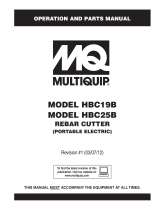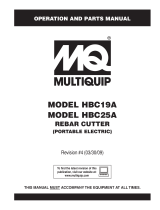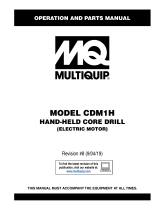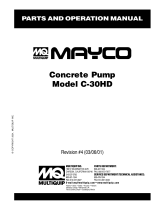
JIMMY SERIES HYDRAULIC REBAR BENDERS — OPERATION AND PARTS MANUAL — REV. #9 (01/04/08) — PAGE 7
JIMMY SERIES HYDRAULIC REBAR BENDERS — RULES FOR SAFE OPERATION
UNIT SAFETY INSTRUCTIONS
■
All hose connections must be tightened with the proper
tools before operating hydraulic power unit. DO NOT over
tighten. Connections should only be tightened securely
and leak-free. Over tightening can cause premature thread
failure or high-pressure fittings to split at pressures lower
than their rated capacities.
■
Should a hydraulic hose ever rupture, burst, or need to
be disconnected, immediately shut off the pump and
release all pressure. NEVER attempt to grasp a leaking
pressurized hose with your hands. The force of escaping
hydraulic fluid could cause serious injury.
■
NEVER subject the hose to potential hazard such as
fire, sharp surfaces, extreme heat or cold, or heavy
impact. DO NOT allow the hose to kink, twist curl, crush,
cut, or bend so tightly that the fluid flow within the hose
is blocked or reduced. Periodically inspect the hose for
wear, because any of these conditions can damage the
hose and possibly result in personal injury.
■
NEVER use the hose to move attached equipment. Stress
can damage the hose and possibly cause personal injury.
■
Hose material and coupler seals must be compatible with
the hydraulic fluid used. Hoses also must not come in
contact with corrosive materials such as creosote-
impregnated objects and some paints. Hose deterioration
due to corrosive materials can result in personal injury.
Consult the manufacturer before painting a hose. NEVER
paint a coupler.
■
Use only approved accessories and approved hydraulic
fluid. Hoses, seals and all components used in a system
must be compatible with the hydraulic fluid used.
■
DO NOT exceed the rated capacities of the cylinders.
Excess pressure can result in personal injury.
■
Inspect each cylinder and coupler before each shift or
usage to prevent unsafe conditions from developing.
■
DO NOT use cylinders if they are damaged, altered or in
poor condition.
■
DO NOT use cylinders with bent or damaged couplers or
damaged port threads.
■
NEVER use extreme heat to disassemble a hydraulic
cylinder or ram. Metal fatigue and/or seal damage will
result and can lead to unsafe operating conditions.
DANGER - High Pressure Hazard
When extending a cylinder or ram
under load, always insure that the
couplers or port threads have not
been damaged or do not come in
contact with any rigid obstruction.
If this condition does occur, the
coupler’s attaching threads may
become stripped or pulled from the cylinder or ram
resulting in the instantaneous release of high pressure
hydraulic fluid, flying objects, and loss of the load. All of
these possible results could cause serious injury or even
death.
Cylinder hoses, couplings and hydraulic pump must all be
rated for the same operating pressure, correctly connected
and compatible with the hydraulic fluid used. An improperly
matched system could cause the system to fail and
possibly cause serious injury. Always maintain the correct
operating for optimal performance. If you have any
questions, please contact your nearest MQ service center.
CAUTION - System Evaluation
■
Avoid pinch points or crush points that can be created
by the load or parts of the cylinder. Do not wear loose
jewelry when operating the rebar bender.
Moving parts can
crush and cut.
WARNING
keep hands
clear of rollers while
rebar bender is
operating.
ALWAYS




























